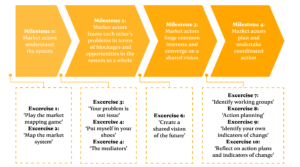Exercises for Market Mapping Workshops
Tried and tested ideas for exercises to steer the participatory process
Tried and tested ideas for exercises to steer the participatory process
Exercises create a focus for the participatory market mapping workshops and help the facilitators to steer the process strategically. Choosing exercises that are right for the state of the relationships between the market actors before each workshop is therefore very important. This guidance note presents some ideas for exercises that will help you to steer the participatory process in a strategic way. How you start the workshop sets the tone for the rest of the event, so below are four key points to ensure appropriate participation by all involved:
Quick introductions: Don’t allow any participant to launch off into a speech – this can kill any initial energy that may exist in the room and put others off.
Everyone speaks: Make sure everyone has a chance to speak to introduce themselves, this will help ‘break the ice’ and bring everyone into the room.
Warm up exercises: Start the workshop with a lively interactive activity – even if it only lasts for 15 minutes.
Explain what to expect: Provide a short summary of the day and the overall event, making sure to draw on the ‘hooks’ you used to bring the market actors to the workshop in the first place.
Figure 1 summarises the recurrent milestones in the participatory market mapping journey and presents the exercises that are appropriate for different parts of the journey. You’ll find a full description of this journey in the Participatory Market Mapping guidance.
Figure 1: Milestones in participatory market mapping and strategic exercises

.tg {border-collapse:collapse;border-spacing:0;}
.tg td{border-color:black;border-style:solid;border-width:1px;font-family:Arial, sans-serif;font-size:14px;
overflow:hidden;padding:10px 5px;word-break:normal;}
.tg th{border-color:black;border-style:solid;border-width:1px;font-family:Arial, sans-serif;font-size:14px;
font-weight:normal;overflow:hidden;padding:10px 5px;word-break:normal;}
.tg .tg-dcmt{border-color:inherit;font-family:Georgia, serif !important;font-size:18px;font-weight:bold;text-align:left;
vertical-align:top}
.tg .tg-e51b{border-color:inherit;font-family:Georgia, serif !important;font-size:15px;text-align:left;vertical-align:top}
.tg .tg-0pky{border-color:inherit;text-align:left;vertical-align:top}
| Exercise | Description |
|---|---|
| 1. Market Mapping Game | This exercise can be used to help people understand the market as a system and the idea of a market map. As well as being used in participatory market mapping forums as an exercise early in the process, it can be used to support the empowerment of marginalised actors. |
| 2. Map the market system | The purpose of this exercise is to facilitate participants to use the Market Map framework to explore their market system and come to an agreement about how it works and how different market actors interact with each other. |
| 3. Your problem is our issue | The purpose of ‘Your problem is our issue’ is to help participants transition from looking at their own problems in isolation to thinking about their own and other market actors’ problems as part of blockages that affect the system as a whole. |
| 4. Put myself in your shoes | ‘Put myself in your shoes’ is a variation on ’Your problem is our issue’. You can use this exercise if you feel that there is too much hostility among participants to allow them to air their grievances and identify other actors who contribute to their problems. |
| 5. The Mediators | The purpose of this exercise is to get participants to frame each others’ problems in terms of systemic blockages. |
| 6. Create a shared vision of the future | The purpose of this activity is to energise market actors to work together strategically to change the way the system works. |
| 7. Identify working groups | The purpose of this exercise is to crowd participants around common interests and to make them commit to meet again to continue trying to address issues. This exercise helps to facilitate market actors to prioritise critical issues in the market system to act on. |
| 8. Action planning | The purpose of this exercise is to get participants to to commit to specific, concrete actions in a coordinated way in order to test out new ways of working in the market system. |
| 9. Identifying your own indicators of change | ‘Identifying your own indicators of change’ builds on the ‘Action planning’ exercise, focusing specifically on how market actors will judge the effects of their actions to address blockages. The purpose of this is to encourage market actors to take action, reflect on the effects of this, and to adapt their new practices for maximum results. |
| 10. Reflect on action plans and indicators of change | The purpose of this exercise is to build on positive momentum for change and and learn from failures by facilitating participants to reflect on the progress against their action plans. |